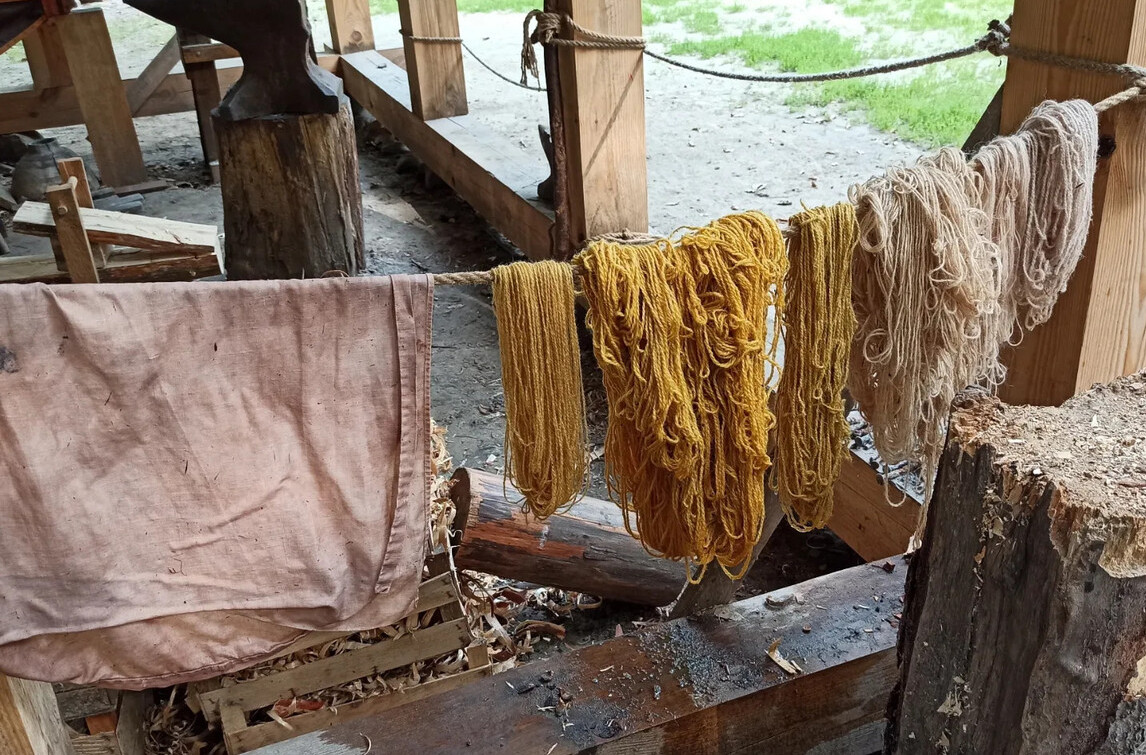The Tricity Wici team spent the summer months adding colour to Grodzisko in Sopot, a branch of the Archaeological Museum in Gdańsk. We had the pleasure of conducting several demonstrations of plant-based dyeing there.
Grodzisko (Polish for a medieval settlement) is a unique place on the map of Sopot. Hidden on a forested hill, beyond the woods, it offers a refuge from the hustle and bustle of the touristy city centre. The museum promotes the history and artefacts of the early medieval Pomeranians. In the summer, you can meet re-enactors and educators here who popularise knowledge about life in the early Middle Ages through the spirit of experimental archaeology.
Experimental archaeology is a branch of archaeology that involves reconstructing and testing ancient techniques, tools, and technological processes under conditions similar to those in which they originally functioned. Its goal is to better understand how people in different eras carried out daily activities, built tools, constructed buildings, and created objects.



Natural Dyeing
During the summer, we had the pleasure of conducting demonstrations on natural dyeing. But what does that actually mean? In simple terms, dyeing yarns and fabrics with plants involves using natural pigments found in the leaves, bark, flowers, fruits, or roots of various plants.
The process includes preparing the dye material, usually by boiling it in water to extract the pigments, and then immersing the fabric or yarn in the solution. To help the dye adhere better to the fibres and improve its durability, a process called mordanting is often used. This involves soaking the material in fixing agents such as alum, iron sulphate, or copper salts.
In the past, dyes and mordants were sourced from the surrounding natural environment—forests, rocks, or mineral deposits—using traditional methods and knowledge passed down through generations.
Which Yarns are Suitable for Dyeing?
Only natural yarns, such as wool, cotton, or linen, are suitable for plant-based dyeing. Animal fibres—wool and silk—absorb colour best, producing vibrant and long-lasting shades. This is due to their chemical composition and fibre structure. Animal fibres consist mainly of proteins—keratin in wool and fibroin in silk. These proteins can form chemical bonds with plant-based dyes, especially in the presence of mordants, which help fix the pigments onto the material. As a result, the dyes penetrate deeply into the fibre structure, ensuring rich and durable colours. We recommend wool dyeing for beginners.
Plant-based fibres, such as cotton and linen, are made of cellulose, which is less chemically reactive and does not bind dyes as effectively as proteins. Therefore, dyeing plant fabrics requires additional steps, such as prolonged mordanting or stronger fixatives, to achieve distinct and lasting colours. Additionally, plant fibres have a more compact structure, making it harder for the dye to penetrate deeply. This makes dyeing plant-based yarns more challenging and time-consuming than dyeing wool or silk. However, with the right approach, beautiful, though typically more muted, shades can be achieved.
We successfully obtained various shades of green on linen (as seen in the linen shirts in the photo) using birch leaves, tansy, and an iron mordant.






Dyeing Yesterday and Today
In the Middle Ages, a vast range of natural dyes was known, and their extraction and use were an essential part of the dyeing craft. Many plants that are now rare or endangered in Europe once grew abundantly and were used both by professional dyers and in household production. Fabric dyeing was an important aspect of daily life, and vibrant colours often indicated the social status of their owner.
One particularly significant dye plant was madder (Rubia tinctorum), whose roots contain a valuable red pigment—alizarin. This dye was used to colour fabrics in various shades of red, from delicate pinks to deep crimson hues. The red obtained from madder was exceptionally durable and highly prized across Europe. Depending on the mordanting method and the type of fibre used, different colour effects could be achieved.
Natural Dyes
Natural dyeing is an adventure that can last for years. At Wici, we experiment with dyeing wool, linen, and finished garments, which we use in early mediaeval reenactment. In the summer of 2023, we tested the following combinations of dyes:

Step-by-Step Guide to Natural Dyeing
Dyeing with natural pigments is easier than it might seem, though it requires time and patience. Start by soaking the wool or fabric in water with a mordant, such as alum. Depending on the dye, this can be done either cold or warm. We usually choose the latter, gently heating the pot over a fire and letting the wool absorb the mordant.
In a separate pot, soak the plant material and heat the mixture slowly to release as much pigment as possible. After about an hour, add the wool to the dye bath and leave it to soak for at least another hour. Make sure the water doesn’t boil, as this could damage the fibres. Once the dyeing process is complete, remove the yarn and let it dry in the fresh air. Then, rinse thoroughly to remove any excess dye and plant residues.
A huge thank you to Grodzisko in Sopot and the Archaeological Museum in Gdańsk for hosting us and supporting our dyeing experiments – we look forward to returning in the years to come!


You must be logged in to post a comment.